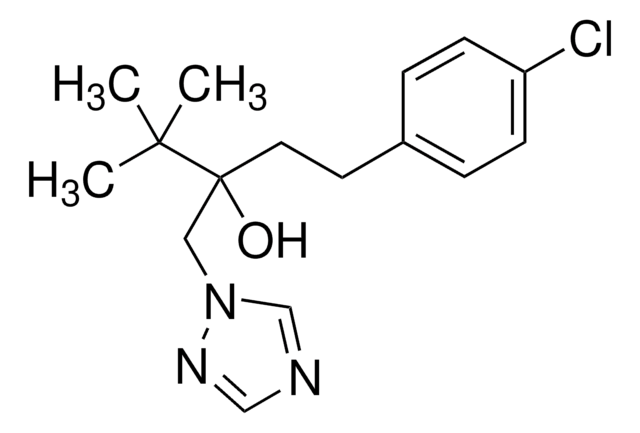Kluczowe dokumenty
45678
Terbuthylazine
PESTANAL®, analytical standard
About This Item
Polecane produkty
klasa czystości
analytical standard
Poziom jakości
linia produktu
PESTANAL®
okres trwałości
limited shelf life, expiry date on the label
metody
solid phase extraction (SPE): suitable
Zastosowanie
agriculture
environmental
format
neat
ciąg SMILES
CCNc1nc(Cl)nc(NC(C)(C)C)n1
InChI
1S/C9H16ClN5/c1-5-11-7-12-6(10)13-8(14-7)15-9(2,3)4/h5H2,1-4H3,(H2,11,12,13,14,15)
Klucz InChI
FZXISNSWEXTPMF-UHFFFAOYSA-N
Szukasz podobnych produktów? Odwiedź Przewodnik dotyczący porównywania produktów
Powiązane kategorie
Opis ogólny
Zastosowanie
- Pesticide distribution and atmospheric persistence: An extensive study reveals the widespread distribution of pesticides, including Terbuthylazine, in the European atmosphere, challenging assumptions about their degradability. This highlights the need for enhanced regulatory measures and monitoring strategies to mitigate environmental and health risks associated with persistent atmospheric contaminants (Mayer et al., 2024).
- Herbicide impact on non-target plant species: Research evaluates the early responses of Solanum nigrum L. to herbicide treatments involving Terbuthylazine, investigating changes in antioxidant activity, osmolyte concentrations, and chlorophyll fluorescence. This study contributes to understanding the selective action of Terbuthylazine and its broader ecological impacts, providing insights for developing more targeted and sustainable herbicidal applications (Hassannejad et al., 2023).
- Human health risk from groundwater herbicide contamination: A human health risk assessment approach is applied to study the occurrence of herbicides, including Terbuthylazine, in the groundwater of Northern Greece. The findings emphasize the importance of continuous environmental monitoring and the development of mitigation strategies to ensure water safety and public health (Parlakidis et al., 2022).
- Seasonal distribution of pesticide residues in water bodies: A study on the seasonal distribution of multiclass pesticide residues in surface waters of northwest Croatia includes Terbuthylazine, discussing the implications for aquatic ecosystems and the effectiveness of current water treatment practices. This research is crucial for assessing the environmental persistence and ecological risks of such chemicals (Fingler et al., 2021).
- Direct pesticide exposure in conservation areas: An investigation into direct pesticide exposure, including Terbuthylazine, in nature conservation areas in Germany, underscores the challenges of protecting vulnerable ecosystems from agricultural chemical intrusion. The study highlights the critical need for stringent environmental protections and pesticide use regulations to preserve biodiversity (Brühl et al., 2021).
Informacje prawne
Nie możesz znaleźć właściwego produktu?
Wypróbuj nasz Narzędzie selektora produktów.
Hasło ostrzegawcze
Warning
Zwroty wskazujące rodzaj zagrożenia
Zwroty wskazujące środki ostrożności
Klasyfikacja zagrożeń
Acute Tox. 4 Oral - Aquatic Acute 1 - Aquatic Chronic 1 - STOT RE 2
Kod klasy składowania
11 - Combustible Solids
Klasa zagrożenia wodnego (WGK)
WGK 2
Temperatura zapłonu (°F)
212.0 °F - closed cup
Temperatura zapłonu (°C)
100 °C - closed cup
Środki ochrony indywidualnej
dust mask type N95 (US), Eyeshields, Faceshields, Gloves
Certyfikaty analizy (CoA)
Poszukaj Certyfikaty analizy (CoA), wpisując numer partii/serii produktów. Numery serii i partii można znaleźć na etykiecie produktu po słowach „seria” lub „partia”.
Masz już ten produkt?
Dokumenty związane z niedawno zakupionymi produktami zostały zamieszczone w Bibliotece dokumentów.
Klienci oglądali również te produkty
Nasz zespół naukowców ma doświadczenie we wszystkich obszarach badań, w tym w naukach przyrodniczych, materiałoznawstwie, syntezie chemicznej, chromatografii, analityce i wielu innych dziedzinach.
Skontaktuj się z zespołem ds. pomocy technicznej



